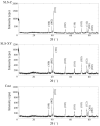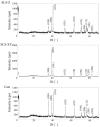Mechanical Properties of Selective Laser Sintering Pure Titanium and Ti-6Al-4V, and Its Anisotropy
- PMID: 33187166
- PMCID: PMC7696245
- DOI: 10.3390/ma13225081
Mechanical Properties of Selective Laser Sintering Pure Titanium and Ti-6Al-4V, and Its Anisotropy
Abstract
Selective laser sintering (SLS) is being developed for dental applications. This study aimed to investigate the properties of Ti-6Al-4V and pure titanium specimens fabricated using the SLS process and compare them with casting specimens. Besides, the effect of the building direction on the properties of the SLS specimens was also investigated. Specimens were prepared by SLS using Ti-6Al-4V powder or pure titanium powder. Casting specimens were also prepared using Ti-6Al-4V alloys and pure titanium. The mechanical properties (tensile strength and elongation), physical properties (surface roughness, contact angle, and Vickers hardness); corrosion resistors (color difference and corrosion), and surface properties (chemical composition and surface observation) were examined. Both Ti-6Al-4V and pure titanium specimens produced using the SLS process had comparable or superior properties compared with casting specimens. In comparing the building directions, specimens fabricated horizontally to the printing platform showed the greatest tensile strength, and the surface roughness scanned in the horizontal direction to the platform showed the smallest. However, there was no significant effect on other properties. Thus, the SLS process with Ti-6Al-4V powder and pure titanium powder has great performance for the fabrication of dental prosthesis, and there is a possibility for it to take the place of conventional methods.
Keywords: CAD/CAM; Ti-6Al-4V; additive manufacturing; pure titanium; selective laser sintering.
Conflict of interest statement
The authors declare no conflict of interest.
Figures










Similar articles
-
Corrosion, ion release, and surface hardness of Ti-6Al-4V and cobalt-chromium alloys produced by CAD-CAM milling and laser sintering.J Prosthet Dent. 2022 Sep;128(3):529.e1-529.e10. doi: 10.1016/j.prosdent.2022.06.011. Epub 2022 Aug 5. J Prosthet Dent. 2022. PMID: 35934573
-
An initial study of diffusion bonds between superplastic Ti-6Al-4V for implant dentistry applications.J Prosthet Dent. 2007 Jun;97(6):357-65. doi: 10.1016/S0022-3913(07)60024-9. J Prosthet Dent. 2007. PMID: 17618918
-
Microstructures and Mechanical Properties of Laser-Sintered Commercially Pure Ti and Ti-6Al-4V Alloy for Dental Applications.Materials (Basel). 2020 Jan 29;13(3):609. doi: 10.3390/ma13030609. Materials (Basel). 2020. PMID: 32013199 Free PMC article.
-
Comparative analysis of corrosion resistance between beta titanium and Ti-6Al-4V alloys: A systematic review.J Trace Elem Med Biol. 2020 Dec;62:126618. doi: 10.1016/j.jtemb.2020.126618. Epub 2020 Jul 9. J Trace Elem Med Biol. 2020. PMID: 32663743
-
The State of the Art in Machining Additively Manufactured Titanium Alloy Ti-6Al-4V.Materials (Basel). 2023 Mar 24;16(7):2583. doi: 10.3390/ma16072583. Materials (Basel). 2023. PMID: 37048881 Free PMC article. Review.
Cited by
-
Influence of building direction on physical and mechanical properties of titanium implants: A systematic review.Heliyon. 2024 May 3;10(9):e30108. doi: 10.1016/j.heliyon.2024.e30108. eCollection 2024 May 15. Heliyon. 2024. PMID: 38774089 Free PMC article. Review.
-
Application of 4D printing in dentistry: A narrative review.J Adv Periodontol Implant Dent. 2024 Mar 16;16(1):55-63. doi: 10.34172/japid.2024.003. eCollection 2024. J Adv Periodontol Implant Dent. 2024. PMID: 39027206 Free PMC article. Review.
-
Dental Materials Applied to 3D and 4D Printing Technologies: A Review.Polymers (Basel). 2023 May 22;15(10):2405. doi: 10.3390/polym15102405. Polymers (Basel). 2023. PMID: 37242980 Free PMC article. Review.
-
Selective Laser Melting and Spark Plasma Sintering: A Perspective on Functional Biomaterials.J Funct Biomater. 2023 Oct 16;14(10):521. doi: 10.3390/jfb14100521. J Funct Biomater. 2023. PMID: 37888186 Free PMC article. Review.
-
Low-Cost Cranioplasty-A Systematic Review of 3D Printing in Medicine.Materials (Basel). 2022 Jul 6;15(14):4731. doi: 10.3390/ma15144731. Materials (Basel). 2022. PMID: 35888198 Free PMC article. Review.
References
-
- Serra-Prat J., Cano-Batalla J., Cabratosa-Termes J., Figueras-Àlvarez O. Adhesion of dental porcelain to cast, milled, and laser-sintered cobalt-chromium alloys: Shear bond strength and sensitivity to thermocycling. J. Prosthet. Dent. 2014;112:600–605. doi: 10.1016/j.prosdent.2014.01.004. - DOI - PubMed
LinkOut - more resources
Full Text Sources
Miscellaneous

